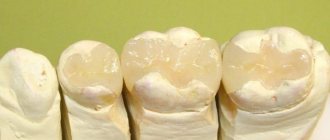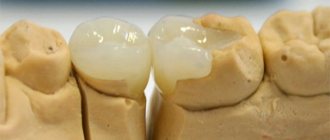Every patient wants to have healthy and beautiful teeth and tries to properly care for them in order to preserve them. But sooner or later, at a dentist’s appointment, problems are discovered that require a choice to be resolved. What should you do if you go to the doctor to treat caries and get a filling, but he strongly recommends a crown? To answer this question, you need to understand the causes of tooth decay, the features of fillings and crowns, the advantages and disadvantages of each type of restoration.
Causes of tooth decay
Tooth decay is a pathological multifactorial process, which is usually caused by a combination of external and internal negative factors. Tissue demineralization occurs, as a result of which enamel and dentin are destroyed and a cavity is formed. If the process is not stopped, the destruction progresses and the size of the defect quickly increases. Why is this happening? Let's list the main factors.
- The presence of cariogenic microflora in the mouth of every person.
- Deficiency of microelements and vitamins in the body: fluorine, molybdenum, phosphorus, strontium, calcium, vitamins B and D; and, as a result, weakness of the hard tissues of the tooth.
- Decrease in pH in the oral cavity due to frequent consumption of carbohydrates and sweet carbonated drinks.
- Pathogenic dental plaque formed by carbohydrate residues.
Restoration methods are divided into 2 categories:
- direct method - performed in the patient’s mouth using photopolymer or light-curing fillings;
- indirect method - making crowns in a dental laboratory.
Question of size and shape
The size and shape of the defect that needs to be restored will be of paramount importance in determining the success of the restoration. For example, if a tooth is significantly damaged, it is easy to understand that the walls of the tooth that will be restored may be thin and weak. As another example, there is a case where the destruction involves an entire corner of the tooth. This will present a more challenging task for the dentist. It is difficult to firmly fix such a restoration to the tooth tissue.
In fact, the size and shape of the cavity are important not only for the correct choice of filling material, but also for predicting the durability of the structure (filling + tooth). The larger the cavity, the more weakened the tooth tissue is. In this case, the filling can act as a wedge. When pressure is applied to the filling, it in turn puts pressure on the walls of the tooth, thereby causing fractures.
Thus, the volume of the filling affects the likelihood of a new tooth fracture. And if this happens, most likely the tooth will be damaged more than the previous time. These are factors that the dentist must consider.
B) Dental crowns. Now let's look at dental crowns and how they differ from restoring a tooth with a filling. On the one hand, unlike a filling, which is located within the tooth, a dental crown covers the tooth from above. And unlike a filling, which can be made from materials that have characteristics that allow them to be used in the oral cavity, a crown is made in a dental laboratory.
What is a filling
A filling is a restoration that is created by filling a cavity or replacing a defect (building up) with filling material. Its main difference from a crown is that it is created directly in the patient’s mouth, and not in a dental laboratory.
A filling is a more familiar method of dental treatment for many, which is considered traditional, proven and reliable. But in fact this is a rather controversial statement. Firstly, a filling can only replace a small defect. Secondly, it is short-lived and cannot guarantee protection from further destruction.
How long can a filling last, and why is it short-lived? Let's figure it out. The best material for a filling or direct restoration is a light-curing composite. Immediately after installation, it really fits perfectly to the walls and looks great. But the most vulnerable place of any restoration is the “filling-tooth” boundary. The fact is that it is not always possible to polish this area perfectly, especially when it comes to the interdental space, and caries very often occurs in this area. Soft carbohydrate food debris can accumulate in this area and after some time, cariogenic microbes accumulate here, consuming carbon from the filling material. After some time, the edge seal in the composite material is inevitably broken. As a result, after 2-3 years, secondary caries is discovered under any filling. To eliminate it, it is necessary to remove the old filling, destroyed tooth tissue (increasing the size of the defect), and put in a new filling. A few years later everything repeats itself. And over time, the remaining walls of the tooth become thinner. The larger the volume of filling material, the more vulnerable the tooth is to mechanical stress; for example, when chewing a bread crust or cracker, a tooth may unexpectedly crack.
How much does it cost to put a crown on a post?
- cleaning the cavity and leveling its walls;
- formation of a pin channel;
- installing a pin into the channel and securing it;
- installation of a seal.
The parapulpal pin is an additional device, which is why, to ensure the quality, strength and duration of the result, other methods are used in parallel to ensure the retention of the filling. Professionalism in working with channels plays an important role.
Sometimes the pin can be seen through the filling. To prevent such defects, special coatings are used, for example, gold plating (yellow color is more natural than steel), plastic.
The price of the finished solution directly depends on the materials of the pin and crown. The cost of a regular anchor pin is 500 rubles, but for a fiberglass one you will have to pay more than 1000 rubles. But these figures pale in comparison with the range of prices for crowns. If ordinary metal-ceramics costs 6–8 thousand, then products made of ceramics and zirconium will cost three times more. All preparatory manipulations will need to be added to the final amount.
An E-Max ceramic crown on a fiberglass pin, together with all stages of treatment, can cost 30,000 rubles and even more if we are talking about a VIP-class clinic. You can also choose a budget option with a metal-ceramic crown and an anchor or titanium pin. This solution will cost from 12,000 rubles, but is not suitable in all cases.
We invite you to familiarize yourself with Screw fastening of a crown to an implant
Filling or crown
To make a choice between a filling and a crown, you need to consider several factors:
- cavity size, degree of hard tissue weakening
- cavity shape
- forecast of restoration durability (filling + tooth construction)
It must be remembered that secondary caries develops under the filling; with a large volume of restoration, there is a risk of fracture of weakened hard tissues. Therefore, the only advantage of a filling over a crown is its low price and speed of production. But if you take into account that in a few years you will have to change the filling, it becomes clear that in the end such a restoration will only cost more.
What types of dental crowns are there?
When choosing a crown, the indications for prosthetics, the client’s wishes, and, of course, the cost of such a service are taken into account. Depending on the material used, prostheses are:
- Metal . This method of restoring teeth is time-tested and reliable, but the disadvantage is the lack of an aesthetic component. Well-known crowns are made of ordinary steel or coated steel, as well as gold. Gold dentures are more preferable because they adhere better to the tooth due to the softness of gold. However, this feature can also be considered one of the disadvantages of metal crowns, because they wear out faster than other types of dentures. Such crowns can withstand the load experienced during chewing. An important fact is that they do not contribute to the abrasion of adjacent teeth. This type of crown is recommended to be placed on molars (side teeth) to hide them when smiling.
- Metal-ceramic . Quite an average option. From the name it becomes clear that they are based on metal and ceramics. The bottom layer of such crowns is a metal base made of an alloy of cobalt with chromium or cobalt with nickel, and the outer layer consists of a ceramic mass. The advantages of these crowns include high hardness and affordable price. Another argument in favor is their good aesthetic appearance. On the contrary, the big disadvantage of metal-ceramic dentures is severe abrasion of the opposite tooth. Despite this, the advantages of this type of prosthetics outweigh the imperfections.
- Ceramic . In terms of biocompatibility and aesthetic appearance, such crowns are the most successful. Their color is close to the natural color of teeth. Unlike gold crowns, ceramic ones are an ideal type for prosthetic restoration of front teeth. The disadvantages include the high cost of such prostheses, as well as not very high strength, which makes their installation in the molar area undesirable.
There are also crowns made of plastic and metal-plastic. Unfortunately, the shelf life of these prostheses is short: from a year to 3 years. The introduction of such prostheses has only a temporary function. Perhaps the biggest advantage of plastic crowns is their relatively low cost. They protect the ground tooth while the permanent crowns are being made.
Benefits of restoring a tooth with a crown
Dental restoration with crowns has many advantages over fillings.
Protecting remaining tooth tissue from recurrent caries
If a significant part of the tooth is destroyed, the dentist will recommend making a stump inlay and covering the tooth with a crown. This method allows you to save the tooth and protect it from secondary caries. Food does not get under the crown and inlay, and the marginal seal inside is not disturbed. Therefore, the tooth is not destroyed.
A crown is the most reliable way to preserve your “native tooth” from chips and breakages
Weakened hard tooth tissues with thin walls become fragile. In this condition, even a small mechanical impact is enough to cause a microcrack to form and a piece of the tooth to break off (for example, when biting a nut). The crown reliably protects against chips and breaks.
The indirect restoration method improves the quality of restoration
The advantages of the direct method, i.e. fillings – speed and low price. However, the main goal of aesthetic restoration and restoration - preventing the destruction of deep layers, restoring the natural shape of the tooth and maintaining the bite - in this case it is not always possible to achieve, the doctor’s view of the oral cavity is quite limited. In addition, crowns can now be made in 2-3 hours (using Cerec technology).
When making a crown, it is possible to model the anatomically correct shape of the restoration, getting as close as possible to the individual characteristics of the patient’s dental system. When filling, the dentist does not have this option. Also, ceramic microprostheses are more durable, practically do not shrink, are firmly fixed on the crown of the tooth and strengthen the walls, do not wear out, and do not change color. Thanks to the smooth surface of the ceramic, plaque with pathogenic bacteria does not form on it. Crowns provide precise marginal fit, and some have an additional antibacterial effect.
What is the difference between a dental crown and a filling?
Before you can understand why it might be important to cap a tooth with a crown, you must understand how crowns differ from dental fillings. Yes, both types of work can be used to restore teeth to their original shape. But still, the functions that they will perform ultimately differ.
We invite you to familiarize yourself with Salivary gland cancer: symptoms, prognosis, treatment and stages
A) fillings.
A filling is a restoration that is attached to the wall of a tooth. Imagine a tooth. Then imagine that part of the tooth is missing. Restoration with filling material will fill the missing part of the tooth and return it to its original shape.
Methods of aesthetic dental restoration
The most popular is the direct method of dental restoration. A similar procedure consists of building up molars using composite materials and special tools. This method is often used on the front teeth. The indirect method requires the manufacture of onlays designed to be installed on the incisors.
Direct method
Aesthetic restoration carried out using the direct method involves building up or restoring teeth through the use of special dental materials. This stage of treatment is most often the final stage in eliminating caries.
Self-hardening composite materials provide good aesthetic results. Artistic restoration helps to get rid of an artistic defect in the teeth, allows you to correct the shape or increase the length of the incisor. The method can also be used to eliminate chips and chips.
To ensure that the tooth restored according to this plan does not differ from the natural one in transparency and color, the material is applied in layers. The effect obtained during the procedure can be compared with the outcome of installing veneers and lumineers.
An undeniable advantage is also that the procedure is one-stage, that is, it can be carried out in 1 day. To achieve better results, you should whiten your tooth enamel a month before surgery.
The following composite products are used for restoration:
- composite - photopolymer, hardening under the influence of light, held on the surface due to chemical bonding, adhesive,
- compomer - has a composite ionomer composition, characterized by aesthetics and stability. Compomer is a wear-resistant and durable material, used to achieve high aesthetics; it releases fluoride into the enamel.
The direct method allows all stages of the recovery procedure to be completed in one visit. For volumetric losses, pin restoration is often used. The most popular designs are:
Before installation, the specialist prepares the canal for insertion of the pin by expanding the orifice. After such manipulation, the pin is fixed using adhesive technology or attached to cement.
Indirect method
In cases where the modeling of the materials used for restoration is carried out in a laboratory, and not in the patient’s oral cavity, the restoration technique is considered as indirect. These methods include:
- veneers,
- lumineers,
- crowns
The disadvantage of all of these methods is the impossibility of performing restoration in one procedure. These products are characterized by lengthy preparation stages and high cost. The undeniable advantage of indirect methods is high strength and long service life.
A veneer is a thin overlay made of durable material. This material is used to eliminate all external defects.
Veneers can be:
- composite,
- ceramic,
- componeers,
- porcelain,
- zirconium,
- Composers
Lumineer is an achievement of modern aesthetic dentistry. Currently, it is considered as the most effective way to restore the aesthetic integrity of the dentition, without causing any harm to the enamel. Installation of lumineers does not require grinding of the tooth.
A crown is a non-removable dental prosthesis, presented in the form of a single element of a row. The prosthesis is made according to an individual impression in a dental laboratory, and then attached to the tooth. Due to this design, replacement of the crown part of the tooth is ensured in the case. When it has significant damage. It is worth remembering that crowns can be installed not only on a tooth, but also on an implant.
Veneers and lumineers are thin plates that follow the shape of the tooth and are applied to the element from the outside. The crown most often covers the entire chewing part of the incisor, but in some cases half-crowns can also be installed.
Why you can’t fill a large defect
Theoretically, this can be done. Modern filling materials make it possible to restore even a unit from which only the root remains. But how long will such a tooth last?
After removing the changed tissues, the tooth will be left with a large cavity with thin walls. The installed filling is not a reinforcing element. The material simply fills the resulting cavity. When chewing, the load is transferred to the walls and a fracture occurs. Often the root also breaks, after which there is no talk of saving the tooth.
That is why the dentist will most likely recommend covering a tooth with a large filling with a crown.
Crowns are the most common method of restoring the functionality of teeth:
- Injured;
- With chips and cracks;
- Destroyed by caries;
- Changed color.
In all these cases, other methods either cannot be used or will not solve the problem.
There may also be a process of destruction under the crown, in most cases this is due to poor hygiene or improper use of the orthopedic structure, for example, associated with excessive loads.
Over time:
- The amount of bone tissue decreases;
- The edges of the crown under the gum become exposed;
- There is a possibility of saliva getting under the crown.
All these moments provoke further tooth destruction. To exclude such a development of events, it is necessary to replace crowns in a timely manner.
When is it necessary to place crowns?
The use of crowns is the optimal solution in the following cases:
- If significant destruction has occurred due to injury or caries;
- After root canal treatment;
- When preparing abutment teeth for prosthetics;
- For prosthetics on implants;
- If it is necessary to change the shape of a tooth, its location in the dentition;
- To improve your smile.
The main differences between fillings and crowns
- Fillings are less durable.
- If the filling falls out, you have to redo all the work; if the crown falls out, you can reinstall it.
- It is impossible to strengthen the thinned walls of a tooth using a filling.
- Installing crowns will take longer.
- Over time, the filling material changes its shades and becomes covered with plaque, but the surface of the crown remains unchanged.
- Crowns can effectively restore the appearance of a tooth and its functionality.
- To install a crown, you will need special treatment of the tooth - grinding and, if necessary, removal of nerves.
A crown is not installed if the patient:
- Severe periodontitis;
- Deep bite;
- Increased abrasion;
- Bruxism.
Prosthetics cannot be used if there is a deep chipping of the tooth wall. Filling has no contraindications. The technique allows you to eliminate almost any defect, but successful operation will not always follow. Restoring a tooth with a filling is inexpensive and is carried out in one visit, but the cost of treatment cannot be used as a criterion, since apparent savings can lead to a negative result when the tooth has to be removed.
The crown is installed once, lasts a long time, can withstand high loads and has a positive effect on aesthetics.
The question of the correct choice of restoration method does not have a clear answer. The dentist will suggest the best option based on the clinical picture. It is best to listen to the arguments of a professional who will correctly assess the condition of the tooth and make an informed choice.
What is better to choose - a crown or a filling?
Which method should be preferred if the patient's tooth is partially destroyed - install a filling or cover it with a crown?
According to experts, one should proceed from the condition of the tooth.
- With a low degree of damage, if the nerve is not affected, modern filling material completely ensures tightness. After filling, such a tooth will function normally, fully participating in chewing food.
- Filling is recommended if tooth decay does not exceed one third of it. In case of severe destruction and absence of a nerve, a filling will not be able to restore tightness and integrity. There is a high probability that caries will develop under the filling.
- If the destruction is large-scale and the tooth is pulpless, the most effective option would be restoration with a crown. If you neglect this rule and fill a significantly damaged tooth, then with a full chewing load, the thin walls are highly likely to crack. Such a chip can be deep and cause tooth extraction. Then you will have to install an implant.










